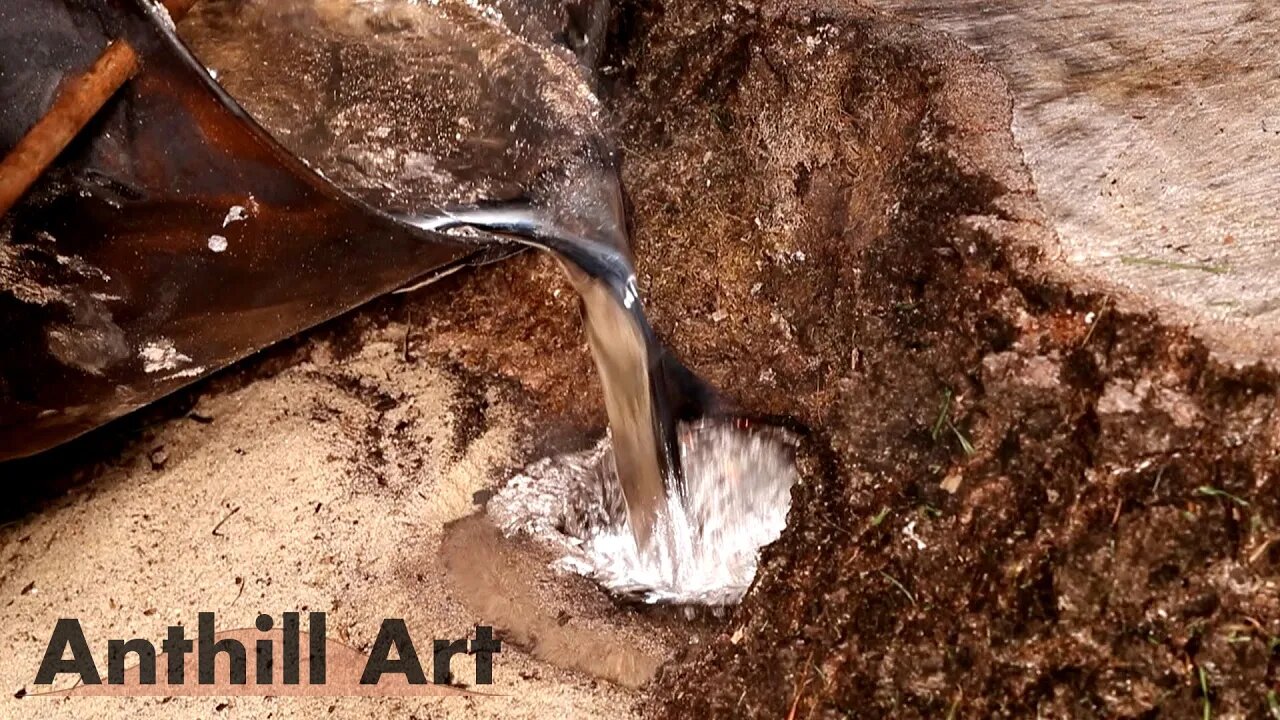Premium Only Content

Craziest Cast Yet! – Casting an Ant Colony in a Stump with Molten Aluminum (Cast #121)
This is the possibly the craziest cast I’ve ever attempted and definitely the most challenging. This is a field ant colony (species Formica pallidefulva) with a single entrance tunnel right up against a large oak stump. Around 22 lb of aluminum was melted and it ended up taking around 10 lb to fill the colony. I didn’t know how exactly how to go about getting the cast out but I knew 1) I can cut wood and 2) I can dig dirt. So, how hard can it be? Turns out, it can be really hard.
I started to dig and cut initially, before deciding that doing that was going to be too difficult. Then I tried burning for two days and that seemed way too slow. I was posting my progress to my Facebook page (https://www.facebook.com/anthillart), and someone suggested drilling holes to make vents in the wood to target certain pieces, which I tried. Then it occurred to me that if I drilled into a section of wood from two angles, I could be fairly sure I wasn’t cutting into the cast if I cut down the line of the drill holes. These ants don’t tunnel in wood and the colony is only in the dirt pockets, so if I’m drilling and I hit dirt then I know not to cut to that depth. I don’t show the drilling much in the video but I’m doing that before most cuts. That’s why you see so many holes in the wood.
I actually didn’t plan on keeping the cast in the wood until the very end, which is why I wasn’t worrying too much about the damage I was doing to it. All for the better though because it would have taken much longer and probably wouldn’t have turned out as cool if I had planned to keep it in the wood. Toward the end, when I’m cutting on the back side of the cast, I still didn’t know if there would be a piece of cast sticking out on that side, once I saw that it was all contained well within the wood, I decided to keep it in the wood.
The cast has two main sections: the piece that comes out of the front and a more hidden piece that runs straight down in a vertical void in the wood. I only discovered that second piece after washing it.
It took ten days from the pour for the cast to be removed from the ground, around 40 hours worth of work. Some of that time was setting up cameras and even more of it was me scratching my head though.
Figuring out the mounting was a major task for me. I settled on drilling 3/4” holes on three sides of the wood and inserting oak dowels, as close to horizontal as I could. Then I built the base so that it catches those oak dowels and the cast can sit upright and be stable.
The colony is around 20” deep and the weight of the aluminum is around 10 lb. The total weight of the wood and the cast was 38 lb last I checked (it’s still drying and getting lighter).
I wasn’t quite sure to what extent I should clean up the wood but I sanded it a little bit and tried to remove any splinters. I started to plug some of the holes but didn’t like how that was working so I just left them. I may do more work on it as it dries. I’m not too sure what’s going to happen as the wood dries and splits but I used Pentacryl to help preserve the wood and have taken other measures. We’ll see!
More pics of the cast at: https://www.anthillart.com/castings/121/
-
 1:28:42
1:28:42
Redacted News
6 hours agoBREAKING! SOMETHING BIG IS HAPPENING IN EUROPE ALL OUT WAR IS COMING AGAINST RUSSIA, TRUMP FURIOUS
121K272 -
 47:50
47:50
Candace Show Podcast
6 hours agoBREAKING: Judge Makes Statement Regarding Taylor Swift's Text Messages. | Candace Ep 155
113K110 -
 1:14:23
1:14:23
Josh Pate's College Football Show
3 hours ago $0.29 earnedCFB’s Most Hated Teams | FSU & Clemson Future | Big Ten Win Totals | Star Rankings Overrated?
14.5K -
 1:33:47
1:33:47
CatfishedOnline
5 hours agoGoing Live With Robert - Weekly Recap
27.8K -
 55:18
55:18
LFA TV
1 day agoEurope’s Sudden Turn Against America | TRUMPET DAILY 3.6.25 7PM
32.2K3 -
 4:21
4:21
Tundra Tactical
4 hours ago $2.12 earnedPam Bondi MUST Enforce Due Process NOW!
23.7K1 -
 56:42
56:42
VSiNLive
5 hours agoFollow the Money with Mitch Moss & Pauly Howard | Hour 1
48K1 -
 1:05:32
1:05:32
In The Litter Box w/ Jewels & Catturd
1 day agoShalom Hamas | In the Litter Box w/ Jewels & Catturd – Ep. 756 – 3/6/2025
103K37 -
 1:23:00
1:23:00
Sean Unpaved
7 hours ago $3.19 earnedNFL Free Agency
53.4K3 -
 18:25
18:25
Stephen Gardner
6 hours ago🔥The REAL REASON the Epstein Files are being HIDDEN | I CONFRONT Alan Dershowitz for details!
66.2K125